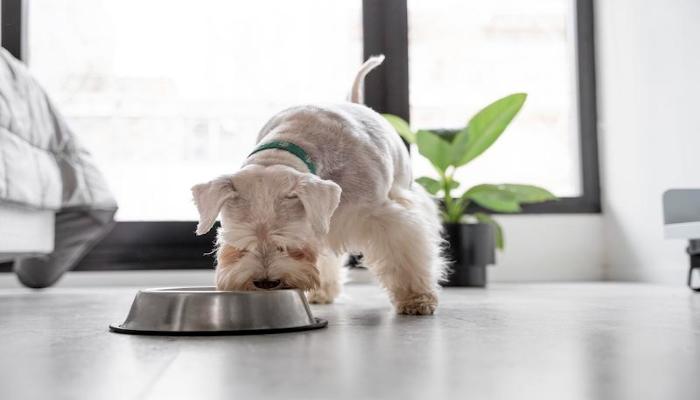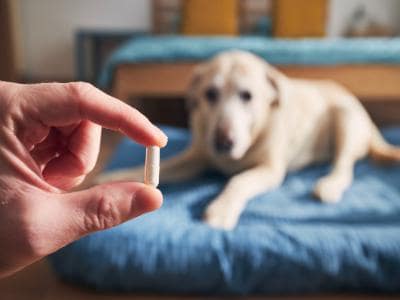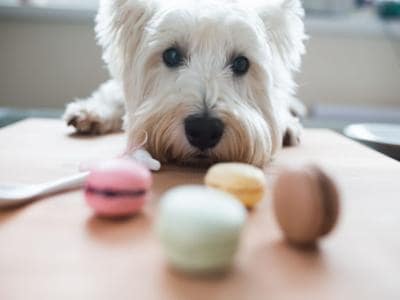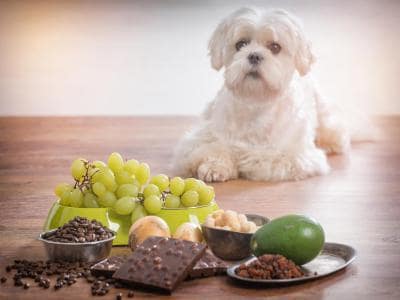Chocolate, Nuts, Onion, and Garlic all sound very normal to us humans but they can be extremely harmful to our dogs. In this blog, we are going to find out “What household items can kill a dog instantly?”
Things that may be useful or not harmful to us can damage our dog’s health severely and also kill them instantly in some cases. To prevent this we need to have a basic idea about our dog and the things that surround our house, so without any further ado let’s begin!

What Household Items Can Kill a Dog Instantly?
Our dogs bring happiness to our life and house, but their curious nature sometimes puts them in a dangerous situation.
Understanding the risk associated with everyday household items is important for the responsibility of pet parenting. Now let’s see what are the things that can kill dogs instantly:
1. Harmful Medicines
There are some medicines in our homes that can be fatal for our dogs even in small amounts. Here are some of them:
Antidepressants
Dogs can be very sensitive to antidepressant medicines, which may cause a range of adverse effects such as vomiting, lethargy, and even seizures.
Some antidepressants, like selective serotonin reuptake inhibitors (SSRIs), can be very toxic[1]. It is vital to store these medications securely, making sure they are out of your dog’s reach.
Painkillers
While pain relief is essential for humans, some painkillers, such as opioids and nonsteroidal anti-inflammatory drugs (NSAIDs), can be life-threatening for dogs[2].

Swallowing these medications can lead to gastrointestinal ulcers, kidney failure, and other complications.
Pet owners must exercise caution when handling and storing painkillers to prevent accidental ingestion by their dogs.
Blood Pressure Medications
Dogs are sensitive to the effects of blood pressure medications, including beta-blockers and calcium channel blockers.
Consuming these substances can lead to a drop in blood pressure, causing weakness, lethargy, and even collapse. Securing these medications in a pet-proof location is crucial to prevent accidental consumption.
Storing medications in cabinets or places inaccessible to your dog, keeping a watchful eye on your pet’s behaviour, and quickly seeking the vet’s attention if you feel your dog consumed something that can be harmful to him.
2. Edible Hazards
Our dogs sometimes have a curiosity for exploring things and food, and while sharing food can be tempting, not all foods that are edible to humans are safe for dogs.
Understanding the potential harm is important, here are some of those foods:
Coffee
Renee Schmid from VCA Hospitals says, “Caffeine, present in coffee and other caffeinated drinks and foods, can be highly toxic to dogs.” Consumption may lead to restlessness, rapid breathing, increased heart rate, and, in severe cases, tremors or seizures.
It is critical to keep coffee grounds, beans, and caffeinated products out of reach to prevent accidental consumption by our dogs.

Macadamia Nuts
Macadamia nuts contain a harmful substance that can make dogs very sick.
Even a small amount can cause problems like weakness, vomiting, shaking, and a high body temperature. It’s very important to keep macadamia nuts and any foods containing them far away from dogs.
Onions and Garlic
Onions and garlic belong to a plant family that has compounds that can damage a dog’s red blood cells, leading to anaemia (low red blood cell count).
Eating these vegetables, whether raw, cooked, or in powder form, may cause symptoms like low energy, pale gums, and urine that is a different colour than normal.
Pet owners should avoid giving dogs any meals seasoned with onions and garlic. Also, make sure onions and garlic are stored securely where dogs cannot get to them.
Alcohol
Dogs are highly sensitive to alcohol, and even small amounts can lead to intoxication, affecting coordination, causing respiratory failure, and potentially being fatal.
Alcoholic beverages, as well as products containing alcohol (like certain desserts), must be kept well out of reach of our dogs.
Xylitol
Found in sugar-free gum, candy, and various other sugar-free products, xylitol can cause a sudden release of insulin in dogs, leading to hypoglycemia (low blood sugar).

Symptoms may include vomiting, loss of coordination, and seizures. Pet owners must be vigilant in checking ingredient labels and keeping xylitol-containing items away from their dogs.
Avocados
While avocados contain a substance called persin, which can be toxic to some animals, the main concern for dogs is the risk of obstruction if they consume the pit.
Additionally, the high-fat content in avocados can lead to pancreatitis in dogs, causing abdominal pain and vomiting.
Chocolate
Chocolate contains theobromine, a stimulant that can be toxic to dogs.
Dark chocolate and baking chocolate have higher theobromine content, leading to more severe symptoms such as tremors, increased heart rate, and, in extreme cases, seizures or death.
All forms of chocolate should be kept out of reach of dogs.
Grapes and Raisins
The exact toxic substance in grapes and raisins is unknown, but consumption can lead to kidney failure in dogs.
Even small amounts can be harmful, so pet parents should be cautious and avoid giving grapes or raisins to their dogs.

3. Lesser-Known Risks
While certain household items might seem harmless, some pose significant risks to our dogs if they consume them. Understanding and being proactive about these lesser-known hazards is important for our dogs.
Antifreeze
Antifreeze contains ethylene glycol, a highly toxic substance for dogs. Even small amounts can lead to severe kidney damage and, if not treated quickly, it may harm them badly.
Dogs are attracted to the sweet taste of antifreeze, so it’s crucial to store it securely and clean up any spills immediately.
Rat Poison
Products used to kill rats and mice can be very dangerous for dogs. These rat poisons often contain toxic chemicals that prevent blood from clotting properly, which can cause internal bleeding.
It’s important to store rat poisons where dogs cannot reach them. If you need to control rodents, use pet-safe methods instead.
Slug Bait
Many products used to kill slugs contain a chemical called metaldehyde which is highly toxic to dogs. If a dog eats slug bait, it can cause very serious neurological symptoms like tremors, seizures, and even death.
Pet owners should use slug control methods that are safe for pets and keep slug baits far away from their dogs.
Cleaning Products
Many household cleaning products can make dogs sick if swallowed. This includes things like bleach, ammonia, and certain disinfectants.

Dogs may be drawn to the smells or any residue left behind from these products. To keep dogs safe, always store cleaning supplies in cabinets that dogs cannot get into.
After using cleaning products, make sure to rinse surfaces very well so there is no residue remaining that a dog could accidentally lick or ingest. It’s important to be careful with these products around pets.
Several common household plants can be toxic to dogs if consumed. Here are some examples:
- Lilies: Certain kinds of lilies, like Easter lilies and Tiger lilies, can cause kidney failure in cats. They are also harmful to dogs, but not as bad.
- Poinsettias: These plants were once thought to be very poisonous, but they can only cause mild stomach upset if a dog eats them.
- Philodendron: If a dog eats this plant, it can irritate their mouth, make them drool a lot, and make it hard to swallow.
- Sago Palm: Every part of this plant is toxic to dogs. Eating it can cause vomiting, diarrhoea, seizures, and even liver failure.
It’s best to keep dogs away from house plants as many types can make them sick if nibbled or eaten. Watch your dog carefully around plants.
Pet owners should research the plants in their homes and gardens to ensure they are safe for dogs. If unsure, it’s best to consult with a vet.
FAQs
Do Dogs Survive Poison?
Dogs who don’t ingest much of a toxic substance and those who receive treatment quickly generally have a better chance at survival. Depending on the type of poisoning, dogs may take weeks or months to recuperate, and some dogs may have permanent organ damage after recovery.
What Household Items Can Kill a Dog Instantly?
These range from avocados, grapes, onions, chocolate, alcohol, and yeast dough. We will also address dog poisoning symptoms from foods like macadamia nuts and sugar-free products, such as chewing gum or peanut butter, and the effects of bones, sweetcorn, and high-fat foods on your dog’s digestive system.
What Are the Signs of Poisoning in Dogs?
Some common symptoms to watch for include foaming at the mouth, lethargy, shaking or unusual movements, upset stomach, unusual swelling, pale gums, or behavioural changes. If you notice your dog displaying any of these symptoms, or if you suspect your dog ingested something toxic, call your veterinarian immediately.
What Is Most Poisonous to a Dog?
Ethylene glycol, antifreeze, is extremely toxic to dogs. It has a sweet taste and thus dogs will drink it. As little as 2 1/2 tablespoons can kill a medium-sized dog in 2–3 days. This type of poisoning is often fatal as dog owners do not know their pet has ingested the antifreeze.
Are Onions Poisonous to Dogs?
Yes, onions are toxic to dogs and should not be ingested. Onions contain a toxic principle known as N-propyl disulfide. This compound causes a breakdown of red blood cells, leading to anaemia in dogs. The toxin causes oxidative damage to your dog’s red blood cells by attaching to the oxygen molecules in those cells.
Conclusion
In conclusion “What household items can kill a dog instantly?” Keeping our dogs safe from household harmful things is our priority.
It is important to keep them away from dangerous cleaning products and plants, these are some steps to create a safe environment for our dogs. Besides this, regular awareness, proper storage, and quick action are the keys to a dog’s well-being.
Remember, keeping them safe and happy is up to you as responsible pet parents!
References:



